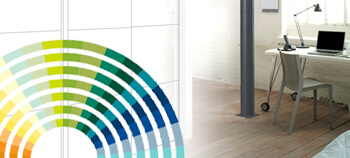
Put the hammer down
Before you go jumping for the hammer and nails, stop to think about what you want to put up and why. Taking the time to prepare properly can save you having to undo everything and start again when you realise you don’t like your finished work.There are several factors to consider when choosing pieces, but the most important one to consider is how personal the art, pictures and photos you want to hang are to you. Your wall art is perhaps the most personal reflection of yourself and your taste in your home, so rather than putting anything generic up think carefully and only choose pieces that really speak to you.
For smaller pieces that you want to combine to make an arrangement, make a practise template first. Lay down a sheet or large piece of butcher paper so you have a clear canvas to arrange on and try the pictures in different combinations. When it comes to fixing them to the wall, you’ll be glad you are already certain about the layout.
It’s all in the measurements
Now you know what you want to put up, you need to find the right spot. The golden rule for all wall hanging is that single pieces should be sixty inches above the floor from the centre of the picture, the rough average for eye level. Stick to this number and you will find that your pictures look like they’re just right instead of feeling at odds with the rest of the room.Staying as close as possible in compliance with this rule, you also want to keep other measurements in mind. If you are hanging above a piece of furniture, leave at least a gap of between three and six inches for a sofa, and at least four-eight inches for a table. For arrangements of several pieces, make sure there are two inches on all sides between larger pictures, shrinking to around an inch and a half to separate small ones.
For the process itself, it pays to recruit a willing (or coerced!) helper, particularly for holding the art in position while you take a step back to see it properly on the wall. A second pair of hands also help things run smoothly, such as when using a level, ruler and pencil to make sure your pieces are aligned correctly before you attach them to the wall. Don’t be attached to heavy nails as the only way to hang your art either. Picture hooks especially can be a much better option.
The framing touches
The frame of a picture should always compliment rather than dominate it. Think carefully about how it goes with the image. Don’t, for example, use an ornate, old, golden frame for a piece of modern art. Whatever frame brings the image greater focus and attention is always a good choice.Other final things to bear in mind are matching your pieces to your rooms. Living rooms are perfect places for a large, bold piece or two to set the tone, whereas a bedroom calls more for an arrangement of personal photos or a small, peaceful still-life. Arrangements are brilliant opportunities to get creative, but stick to a few rules to give it balance such as sticking to either photographs or art and giving all pieces a similar style and colour frame. Finally, be careful when placing particularly valuable pieces, look out for nearby sources of heat or damp.
Now you should be turning your home into a professional gallery with no trouble at all! Why not invest in a mirrored sliding door wardrobe to bounce light around your space, enhancing your stunning wall art?






